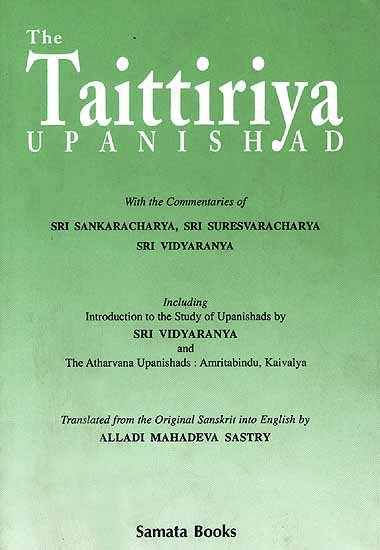Taittiriya Upanishad Bhashya Vartika
by R. Balasubramanian | 151,292 words | ISBN-10: 8185208115 | ISBN-13: 9788185208114
The English translation of Sureshvara’s Taittiriya Vartika, which is a commentary on Shankara’s Bhashya on the Taittiriya Upanishad. Taittiriya Vartika contains a further explanation of the words of Shankara-Acharya, the famous commentator who wrote many texts belonging to Advaita-Vedanta. Sureshvaracharya was his direct disciple and lived in the 9...
Verse 2.335
Sanskrit text and transliteration:
अन्वयव्यतिरेकाभ्यां कोशैरात्मसमीक्षणम् ।
क्रियते हि यतस्तेषामुपायत्वं प्रतीयते ॥ ३३५ ॥
anvayavyatirekābhyāṃ kośairātmasamīkṣaṇam |
kriyate hi yatasteṣāmupāyatvaṃ pratīyate || 335 ||
English translation of verse 2.335:
Since the realization of the Self is, indeed, brought about by the sheaths through the method of agreement and difference, they are regarded as the means thereto.
Notes:
While the Brahmavallī teaches the end to be attained, the Bhṛguvallī sets forth the nature of the sheaths as the means thereto. That is the real which is uniformly present in all things. What is present in some objects and absent in others cannot be the real. One must inquire into the nature of the five sheaths in terms of these principles with a view to find out that factor which is uniformly present (anvaya) in them as distinguished from that which is present in some and absent in others (vyatireka). It has already been stated that these five sheaths are related as cause and effect, and that what is considered to be an effect is not different from its cause. While the cause is present in its effect, we cannot reverse this relation and say that the effect is present in its cause. Though the prāṇamaya is the cause of the annamaya, it is in its turn the effect of the manomaya. Though the vijñānamaya is the cause of the manomaya, it is in its turn the effect of the ānandamaya. It is Brahman which is the cause, the support, of the ānandamaya. Applying the principles of anvaya and vyatireka it has to be said that none of the sheaths is ultimately real, for all of them are evolved principles. When Bhṛgu came to the ānanda. the fifth step in the series (pañcamaparyāya), he stopped his investigation with that, realizing that Brahman is the cause or the support of the ānanda. The five sheaths from the anna to the ānanda constitute the means for realizing Brahman. The ānanda with which Bhṛgu stopped does not stand for the supreme Brahman, but only for the ānandamaya-kośa. It is, therefore, wrong to argue that the ānandamaya in the Brahmavallī refers to the supreme Brahman on the supposition that the ānanda in the Bhṛguvallī refers to Brahman.
